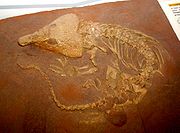
Labidosaurus
Encyclopedia

Anapsid
An anapsid is an amniote whose skull does not have openings near the temples.While "anapsid reptiles" or "anapsida" are traditionally spoken of as if they were a monophyletic group, it has been suggested that several groups of reptiles that had anapsid skulls may be only distantly related...
reptile
Reptile
Reptiles are members of a class of air-breathing, ectothermic vertebrates which are characterized by laying shelled eggs , and having skin covered in scales and/or scutes. They are tetrapods, either having four limbs or being descended from four-limbed ancestors...
from the Permian
Permian
The PermianThe term "Permian" was introduced into geology in 1841 by Sir Sir R. I. Murchison, president of the Geological Society of London, who identified typical strata in extensive Russian explorations undertaken with Edouard de Verneuil; Murchison asserted in 1841 that he named his "Permian...
period of North America. Fossils have been discovered in Texas
Texas
Texas is the second largest U.S. state by both area and population, and the largest state by area in the contiguous United States.The name, based on the Caddo word "Tejas" meaning "friends" or "allies", was applied by the Spanish to the Caddo themselves and to the region of their settlement in...
.
Labidosaurus was heavily built, resembling a lizard
Lizard
Lizards are a widespread group of squamate reptiles, with nearly 3800 species, ranging across all continents except Antarctica as well as most oceanic island chains...
with a large head, and measuring about 75 centimetres (29.5 in) long. It had multiple rows of sharp, conical teeth, suitable for crushing animals with hard shells, such as insects or molluscs, although they may also have eaten tough plants.
A lower jaw of Labidosaurus was described in 2011 that shows evidence of osteomyelitis
Osteomyelitis
Osteomyelitis simply means an infection of the bone or bone marrow...
, or an infection of the bone. It is the earliest known example of an infection in a land vertebrate. The infection probably developed because the pulp
Pulp (tooth)
The dental pulp is the part in the center of a tooth made up of living connective tissue and cells called odontoblasts.- Anatomy :Each person can have a total of up to 52 pulp organs, 32 in the permanent and 20 in the primary teeth....
cavity of a broken dentary tooth was exposed to bacteria
Bacteria
Bacteria are a large domain of prokaryotic microorganisms. Typically a few micrometres in length, bacteria have a wide range of shapes, ranging from spheres to rods and spirals...
. Although another tooth would have replaced the broken one, regeneration would have been slow. Labidosaurus and other early reptiles adapted to herbivory by having teeth that were deeply implanted in the jaws. This deep implantation limited tooth replacement, meaning that a broken tooth would have been exposed for a long period of time.

